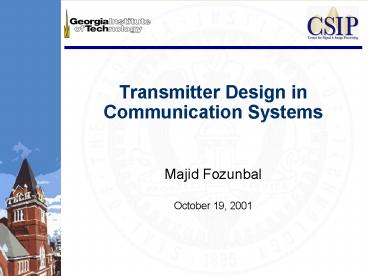Transmitter Design in Communication Systems - PowerPoint PPT Presentation
1 / 17
Title:
Transmitter Design in Communication Systems
Description:
Encoding with CSI in Transmitter. Possible in slowly fading channels. ... Transmitter (Needs CSI). Correlation decreases the diversity gain. ... – PowerPoint PPT presentation
Number of Views:212
Avg rating:3.0/5.0
Title: Transmitter Design in Communication Systems
1
Transmitter Design in Communication Systems
- Majid Fozunbal
- October 19, 2001
2
Outline
- Mathematical insight to communication systems
- General scheme
- Channel
- Transmitter
- Transmission over AWGN channel
- Traditional method
- Coded modulation
- Non-ideal Gaussian channel
- Transmission over fading channels
- Encoding without CSI in transmitter
- Encoding with CSI in transmitter
- Diversity
- Multiple antenna system
3
General Scheme
4
Channel
- Distortion a linear operator.
- Example any causal linear filter.
- Having null space, not invertible.
- Injective, one to one, preserves dimensionality.
- Finite dimension, matrix theory.
- Perturbation
- Noise, interference.
- Uncertainty.
- No overlap, error-free inverse mapping.
- Amount of overlap, error rate.
5
Channel (Cont.)
Channel Output Space
RN
- RSN and RN are normalized per dimension (infinite
dimension). - Gaussian noise.
6
Transmitter
- An injective mapping from message space to signal
space. - Compensating the channel distortion.
- Finite dimension, soft balls, non-zero error
rate. - Tradeoff between spectral efficiency and error
rate defined by region of decision. - Infinite dimension, rigid spheres, zero error
rate. - Increasing dimension, hardening the balls,
increasing the spectral efficiency, decreasing
robustness to noise variance.
7
Transmission over AWGN Channel
- No distortion, just additive white Gaussian
noise. - Band limited channel.
- Constraint Power.
- Goals
- Given an error rate, maximize the spectral
efficiency. - Given a spectral efficiency, minimize the error
rate.
8
Traditional Method
- Separate coding and modulation.
- Adds redundancy to maximize the minimum free
Hamming distance. - Information rate K/N.
- Decreases the spectral efficiency.
4K sequences (4-PSK)
4K out of 4N sequences
9
Coded Modulation
- Combined coding and modulation.
- TCM, Multi-level coding, Coset codes.
- Adding redundancy by using a bigger signal
constellation. - Convolutional coder and nonlinear mapping.
- Maximizing the minimum free Euclidean distance.
4K Sequences (4-PSK)
4K out of 8K (8-PSK)
10
Non-Ideal Gaussian Channel
- Non-ideal AWGN channels suffer ISI.
- Dividing to a bunch of ideal sub-channels.
- Multi-carrier, OFDM.
- Spectral water-filling maximizes power
efficiency. - Bit-loading to optimize spectral efficiency.
Power allocation for sub-channels
11
Transmission over Fading Channel
- Time variable operators.
- Characterized by PDF (Rayleigh, Rician).
- Coherence time, coherence bandwidth.
- Flat fading, slowly fading.
- Channel estimation.
- Fading decreases the channel capacity.
12
Encoding without CSI in Transmitter
- Ergodic channel.
- Time interleaving to achieve capacity.
- Infinite length interleaving is required.
- Suitable for data.
- Delay constraint, no good for speech.
- Uniform power distribution.
- Design criteria
- Maximizing Hamming distance.
- Product distance.
- Note Performance depends on PDF.
13
Encoding with CSI in Transmitter
- Possible in slowly fading channels.
- Transmit more power and data when channel is
good. - Temporal water-filling.
- Bit-loading and variable size modulation skims.
- Adaptive modulation TCM and Multi-level coding.
14
Diversity Techniques
- Diversity changes the statistics of the received
signal. - Time diversity.
- Frequency diversity.
- Space diversity
- Receiver.
- Transmitter (Needs CSI).
- Correlation decreases the diversity gain.
15
Multiple Antenna Systems
X
H
Y
Y H X V
16
MIMO (NO CSI in Transmitter)
- N by N MIMO.
- N times of SISO capacity (no correlation).
- Degrees of freedom
- Combat fading.
- Space-time TCM
- High efficiency.
- Complex decoder.
- Space-time Block Coding
- Maximum diversity.
- Simple decoder.
- Beam-forming.
- BLAST Source separation.
17
MIMO (with CSI in Transmitter)
School of ECE
School of ECE
- Beam-forming in transmitter and receiver.
- Singular value decomposition (SVD).
- A parallel bank of SISO channels.
- Capacity is defined by PDF of singular values.
- Temporal-spatial water-filling.

